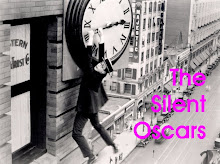 This is my contribution to the Mary Pickford Blogathon, hosted by one of the Monkey's favorite bloggers, KC of Classic Movies.
This is my contribution to the Mary Pickford Blogathon, hosted by one of the Monkey's favorite bloggers, KC of Classic Movies.Amarilly of Clothes-Line Alley was the second of five movies Mary Pickford made in 1918, and the first after the spectacular achievement of Stella Maris. Here, Pickford mines a familiar vein—the collision of the upper and lower classes told through the eyes of a spirited girl from the wrong side of the tracks—this time played mostly for comedy. Although not as iconic as Rebecca of Sunnybrook Farm or The Poor Little Rich Girl, Amarilly of Clothes-Line Alley is a prime example of Pickford's lasting appeal.
 Adapted from Belle K. Miniates's novel by Pickford's friend and favorite screenwriter, the legendary Frances Marion, Amarilly of Clothes-Line Alley is the story of Amarilly Jenkins, "a debutante" of the tenement slum known as "Clothes Line Alley." To support her brothers and sisters, Amarilly takes a job selling cigarettes in a dive bar and winds up falling for a rich, handsome swell out slumming with his rich, handsome pals. The comedy turns on Amarilly's battles with his snobbish family, with our Mary getting the best of them before finally realizing what she really wants in life.
Adapted from Belle K. Miniates's novel by Pickford's friend and favorite screenwriter, the legendary Frances Marion, Amarilly of Clothes-Line Alley is the story of Amarilly Jenkins, "a debutante" of the tenement slum known as "Clothes Line Alley." To support her brothers and sisters, Amarilly takes a job selling cigarettes in a dive bar and winds up falling for a rich, handsome swell out slumming with his rich, handsome pals. The comedy turns on Amarilly's battles with his snobbish family, with our Mary getting the best of them before finally realizing what she really wants in life.Throughout her career, Pickford excelled at light comedy and Amarilly is no exception, turning a ride on the back of a motorcycle, a tumble through a doorway on the threshold of her first kiss, and her enthusiasm for a barroom brawl into nice bits of humor. But it was mostly her bright, searching eyes, her shy, knowing smile, and, above all, her plucky, indomitable spirit that made her so adorable. In fact, if one word could sum up Pickford's extraordinary appeal during the era, "plucky" would be it.
 As you might expect from a film written by Marion, the social observations are tart and biting without overwhelming the comedy. The rich are alternately portrayed as stuffy, lifeless bores and perfumed, pampered bums. Amarilly's love interest (Norman Kerry) is an effete drunk who ducks his work and his family with equal abandon. His best friend is a deadbeat trust fund baby who hogs the guest room and never picks up a check. And his mother is a pompous dowager who founds a charity that actively despises the objects of its care.
As you might expect from a film written by Marion, the social observations are tart and biting without overwhelming the comedy. The rich are alternately portrayed as stuffy, lifeless bores and perfumed, pampered bums. Amarilly's love interest (Norman Kerry) is an effete drunk who ducks his work and his family with equal abandon. His best friend is a deadbeat trust fund baby who hogs the guest room and never picks up a check. And his mother is a pompous dowager who founds a charity that actively despises the objects of its care.The resulting study of American social mobility is more Pygmalion than Cinderella and ends with a twist that thumbs its nose at both literary conventions. I quite can't tell if the film's politics are progressive or reactionary—maybe a bit of both—but no matter: Amarilly's happiness is the only item on the bipartisan agenda.
 To direct Amarilly, Pickford chose Marshall Neilan, who had overseen the hugely successful Stella Maris. This time around, Neilan required none of the special effects or camera tricks that made Pickford's dual role in Stella Maris possible, but his direction is a solid example of the classical Hollywood style then emerging. The pacing is nimble and assured, the acting solid, and the camera work as light on its feet as the story itself.
To direct Amarilly, Pickford chose Marshall Neilan, who had overseen the hugely successful Stella Maris. This time around, Neilan required none of the special effects or camera tricks that made Pickford's dual role in Stella Maris possible, but his direction is a solid example of the classical Hollywood style then emerging. The pacing is nimble and assured, the acting solid, and the camera work as light on its feet as the story itself.One shot in particular, that of Amarilly's steady boyfriend finding the new guy's top hat on the landing outside her door—when compared with, say, Mack Sennett's rather obvious and by then painfully dated park bench sex comedies—shows just how far the movies had come in the space of a couple of years.
 Look also for the way Neilan composes shots contrasting the worlds of the wealthy and the poor. In the former, Amarilly's beau is lost in vast expanses of sterile marble; in the latter, Amarilly's loving family is tucked into a warm, snug room. Neilan further underscores the divide by often framing Amarilly standing in doorways and perched on window sills, literally and symbolically straddling two worlds. Neilan's notions about poverty may be sentimental, but he's making his argument visually, cinematically, rather than spelling everything out with clumsy intertitles.
Look also for the way Neilan composes shots contrasting the worlds of the wealthy and the poor. In the former, Amarilly's beau is lost in vast expanses of sterile marble; in the latter, Amarilly's loving family is tucked into a warm, snug room. Neilan further underscores the divide by often framing Amarilly standing in doorways and perched on window sills, literally and symbolically straddling two worlds. Neilan's notions about poverty may be sentimental, but he's making his argument visually, cinematically, rather than spelling everything out with clumsy intertitles.Despite the chronic alcoholism that made him unreliable and eventually ended his career, Pickford adored Neilan. "[T]o my way of thinking, he was the best director ever, better than the great D.W. Griffith."
 The admiration was mutual. "She has something," Neilan said, "that irrespective of looks or age or anything else, will live on. She has personality."
The admiration was mutual. "She has something," Neilan said, "that irrespective of looks or age or anything else, will live on. She has personality."Amarilly of Clothes-Line Alley premiered on March 11, 1918, and to the surprise of no one, became one of the biggest hits of the year.
 "Mary Pickford," wrote Motion Picture Magazine, "has gone to an entirely different well of characterization for Amarilly and drawn up as full a pitcher of success as in the renowned Stella Maris."
"Mary Pickford," wrote Motion Picture Magazine, "has gone to an entirely different well of characterization for Amarilly and drawn up as full a pitcher of success as in the renowned Stella Maris."After Amarilly, Pickford continued to play plucky young girls in films such as Daddy-Long-Legs, Pollyanna, Tess of the Storm Country and Sparrows. The range of her roles was narrow and often fit the star like a straightjacket. "I'm sick of Cinderella parts," she once admitted, "of wearing rags and tatters. I want to wear smart clothes and play the lover." But fed-up or not, Pickford was not one to trifle with the expectations of a fan base that had made her the most powerful woman in the history of Hollywood.
 "I am a servant of the people," she said, "and I have never forgotten that."
"I am a servant of the people," she said, "and I have never forgotten that."Only after the advent of sound made further little girl roles impossible did Pickford finally abandon the "Little Mary" persona for good. And as she feared, her audience abandoned her as well.






8 comments:
This is one Mary Pickford film that I have always wanted to see. Neilan was her favorite director and they understood one another perfectly. Mary was such a great artist - I am glad we are honoring her.
"She has something," Neilan said, "that irrespective of looks or age or anything else, will live on. She has personality."--quotes like that make me believe that there were plenty of people who felt that the films they made in the early days would somehow endure, even if only in memory. I love this movie because Mary gets to be a least a little more adult, and it suits her. The scene after she is fired from her job and marches defiantly into the shadows is one of my favorites. It's a clear example of the way Chaplin influenced her. Very compelling post. Thanks for contributing!
I like this film because she plays an independent confident young woman who has no problem finding work and isn't ashamed of who her family is and where she came from. I think that's why this film might have been really popular. It wasn't very often you found positive female role-models perhaps in 1918 so it was refreshing. This also makes this film very appealing to a modern audience as well, it has that timeless quality.
MM,
I have to admit that I would have been very disappointed if you hadn't participated in the Pickford Blogathon since you're my favorite blogger on all things silent film!
Now that I've gotten that out of the way, this was a highly enjoyable and informative review.
I mentioned on another review that before I really became a die hard Mary Pickford fan I was a bit annoyed that she kept playing a kid at her age but when you have a formula that works, an adoring audience then why mess with it. (You've obviously touched upon that here as well)
Interesting about Neilan and the mutual admiration he and Mary had for one another although it would be expected. I'm not as familiar with his work as you are so I'll do myself a favor and change that. What three of his films would you recommend I start with?
Thanks for providing yet another stellar review here MM. Very fitting for the talented Mary Pickford.
Page
Thanks, Page. I like doing blog-a-thongs, and feel guilty when I don't participate in ones run by my fellow blog pals. I've been overwhelmed with non-blogging projects recently and have missed some good ones. I think things should settle down soon and I can pick up the pace again.
Well, maybe.
Three Mary Pickford movies. Hmm. Sparrows and Stella Maris are probably my two favorite showcases of her serious acting chops, with the latter featuring her in a double role so convincing you could miss the fact she's playing both major parts. I'd go with one of those two for a Pickford drama.
The Poor Little Rich Girl is probably the most quintessential Pickford movie, and it was a groundbreaking combination of comedy and drama. There's your best bet for Pickford playing a little girl.
And My Best Girl was one of her last silents, a very accessible comedy where she plays a shopgirl rather than a little girl.
I know she won an Oscar for the sound picture Coquette but I think that award was more a result of intense lobbying (the first campaign in Oscar history) than great acting. I don't think A Little Princess works, although plenty of people do. Rebecca of Sunnybrook Farm is very typical but not as good as The Poor Little Rich Girl from the same year.
I really like Mary Pickford. I hope I've steered you in a direction that will lead you to like her, too!
MM,
I was wanting your favorite of Neilan's work, not necessarily with Pickford. : )
I'm guessing you're as exhausted as I am. Blaming my fatigue on the NBA Playoffs and too much sun.
Page
Oh, sorry. Neilan. It was a long weekend for me, too -- a good weekend, but a long weekend.
I would say Stella Maris is definitely his best. Then I'd look at Rebecca of Sunnybrook Farm, which is very typical, and either Daddy-Long-Legs or Amarilly of Clothes-Line Alley.
I'm not a fan of The Little Princess (although the AFI Silver showed it recently with live accompaniment) -- Pickford is trying to play 9 instead of 14, and the camera effects make her look like some sort of garden gnome instead of a child.
Dorothy Vernon of Haddon Hall I have not seen but would like to -- according to Robert Osborne, that's the one where Neilan's alcoholism had become so acute that Pickford directed the entire movie while Neilan watched in bemused silence.
It was a short career and his best work is his early work.
The first reason I liked her was she was Canadian and one of the first female superstars of Hollywood.
Then I saw her movies and understood the appeal. I still find it difficult to believe the public could convince themselves she was a young girl in movies when in actuality she was almost 30 in some roles.
Post a Comment